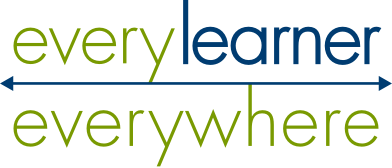As Every Learner Everywhere reflects on Teacher Appreciation Week this year, we are particularly inspired by the leadership role educators take in advancing equity in the classroom for minoritized, poverty-affected, and first-generation college students.
“Educators are the ones on the front lines of the work to close equity gaps,” says Jessica Rowland Williams, Ph.D, Director of Every Learner Everywhere. “They are the ones who students trust and have the most contact with when things come up in the students’ personal lives. They connect students with resources outside of the classrooms. Teachers are critical to ensuring every student has a chance to succeed.”
In the last year, we have been inspired by dozens of examples of classroom educators innovating to create equitable learning for their students, often by thoughtfully incorporating new technology. For example:
- They are creating communities of practice on equitizing the syllabus.
- They are leading challenging conversations on intersectional pedagogy.
- They are reimagining composition assignments to engage every student.
- They are using hyper-local climate justice issues to to teach chemistry.
- They are sharing practical ways to use digital tools in equitable ways.
- They are rethinking assessment to remove barriers to equity.
- They are centering student care in first-year experience programs.
The COVID-19 pandemic in particular has highlighted how progress on equity depends on dedicated classroom teachers. “I am moved by the sheer perseverance and resolve of the faculty during this pandemic,” says Williams. “Everyone is exhausted, but faculty still show up every single day and find ways to inspire students and keep others inspired.”
Designing for every student
Many of the examples above demonstrate a commitment to creating quality learning experiences that are adaptable to every student’s needs. “That’s where innovative educators who are focused on equity concentrate,” Williams explains. “Our students have more responsibilities. Our students are older. Our students have jobs. Forward-thinking faculty are at a place where they are intentionally designing for that and not just being reactive.”
When students have trouble making progress on their degree program, says Williams, “the education system has always thought the problem is with the student. Instead of immediately blaming the student, we should also interrogate the system and the policies and practices that live within the system.”
But creative equity-minded teachers are redesigning learning with each student’s experience in mind, instead of forcing each student to adapt to a learning environment created for the privileged.
One example of that is the biology department at Kingsborough Community College in New York, where many students are first-generation immigrants and non-native English speakers. They were performing well in class but struggled on assessments, so, to close a perceived disconnection between the class learning objectives and the test questions, faculty collaborated with students to rewrite the test questions, and the students’ performance improved.
Meanwhile, individual successes of advancing equity in the classroom are being shared broadly in conferences, webinars, and technical assistance. For example, Achieving the Dream recently led a cohort of college and university faculty in learning a backward course design framework to incorporate equity principles.
Creating better online learning
Faculty are also leading necessary conversations at the intersection of evidence-based teaching, digital learning, and equity. Instead of assuming that technology is race neutral, teachers are creating learning spaces in every modality that are relevant and effective for every student.
That’s a 180-degree turn from a one-size-fits-all “colorblind” approach to online learning that tends to direct minoritized and poverty-affected students to remedial programs. “There’s a tidal change in thinking because faculty are open to new ideas,” says Williams.
“That’s really exciting, especially when it comes to incorporating new technology tools in the classroom. You and I could be using the same courseware and your students could have very different outcomes from my students. It’s not the courseware. There’s no magic in it. It’s how we use it.”
Equity leaders in action
Most of all, Teacher Appreciation Week in 2022 brings to mind how important faculty leadership and creativity are to bridging theory and practice to make equity a reality.
“If I start talking about dismantling systemic racism, you may be on board with that,” Williams says. “But you may also be asking yourself, ‘What does that mean to me? What can I do?’ It’s just so big and abstract.’ The teachers Every Learner Everywhere works with are translating that into the ‘how.’ They are leveraging digital tools in ways that are easy to implement in the classroom.”


